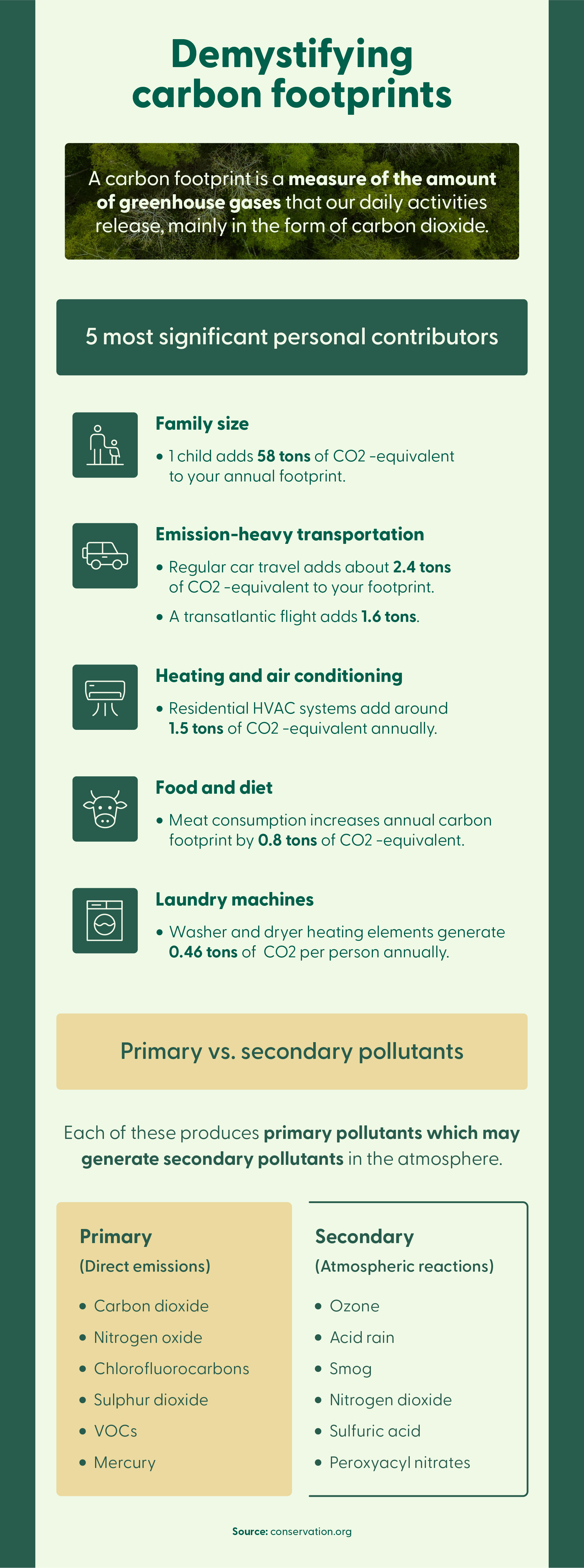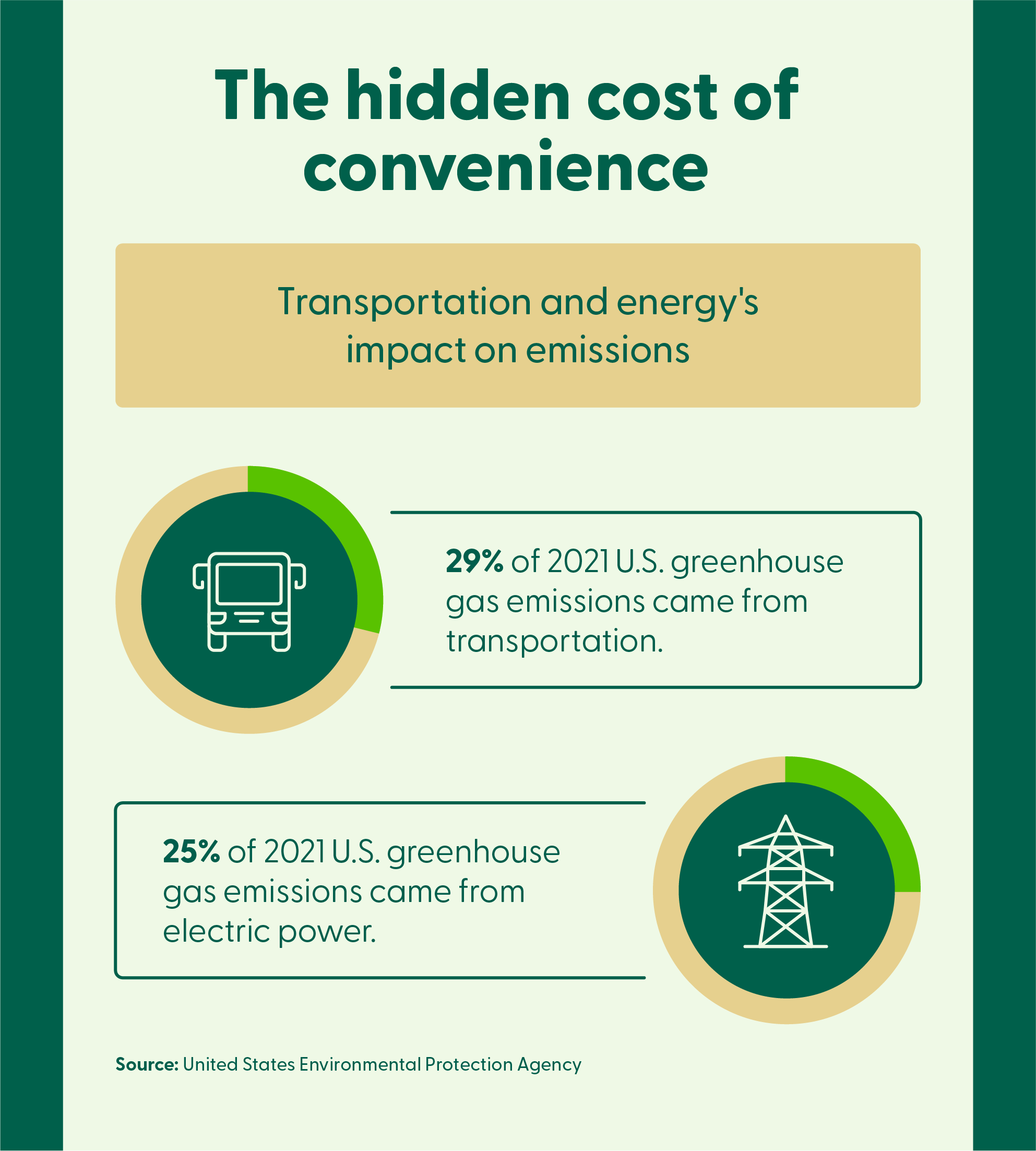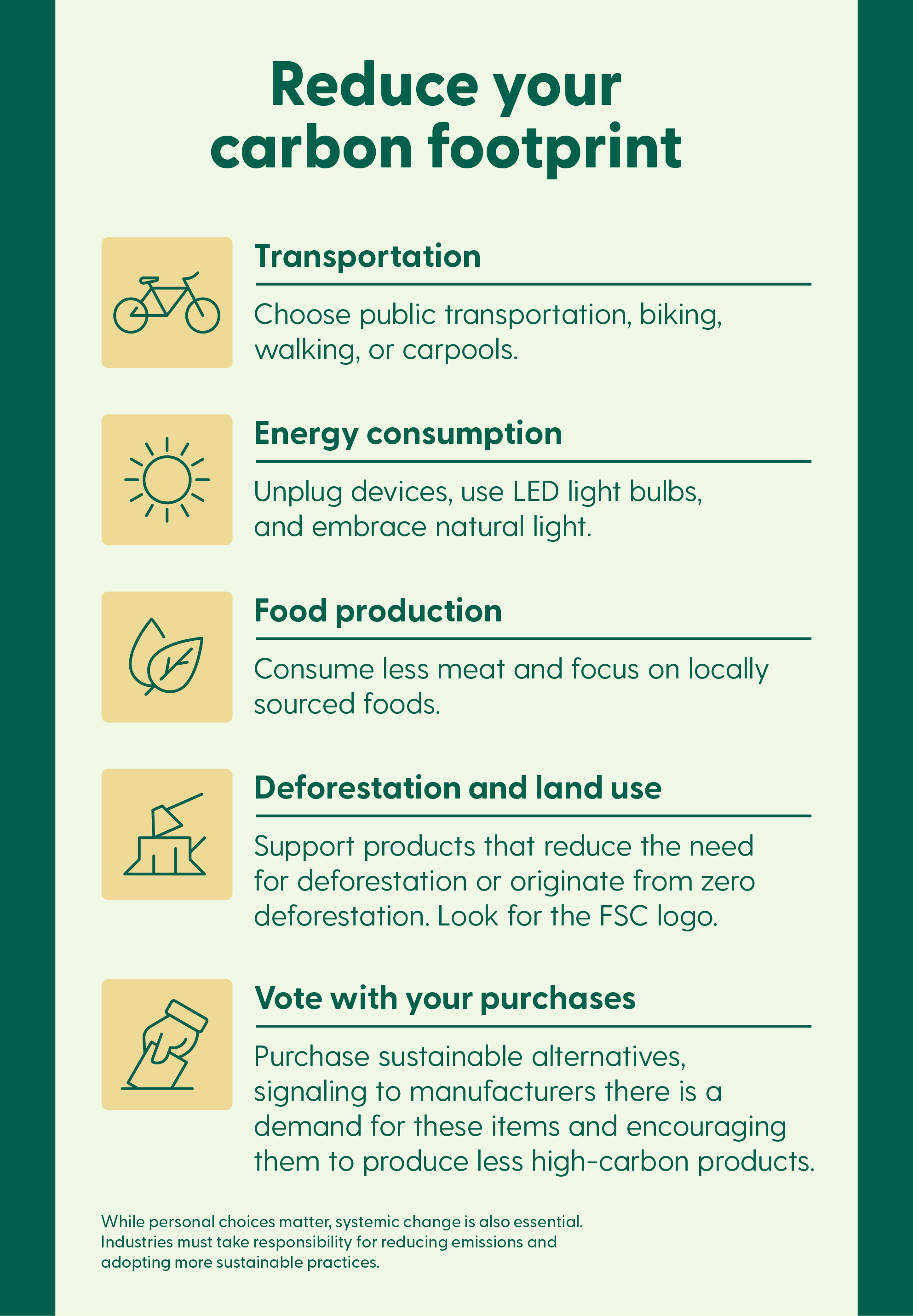
FSC has joined 100+ NGOs supporting the #Together4Forests movement.
A carbon footprint quantifies the environmental impact of everyday actions. It measures the primary and secondary emissions associated with a person or an entity that are released into the atmosphere.
Primary pollutants are classified as emissions directly created from one source at a time, like nitrogen dioxide produced by fossil fuels. Secondary pollutants form in the atmosphere when primary pollutants react with each other. For example, when sunlight reacts with the primary pollutant nitrogen oxide, the reaction creates smog (a secondary pollutant).
According to Conservation International, the average carbon footprint per person globally is 4.8 metric tons of carbon dioxide per year. However, it’s important to note that the concept of a carbon footprint was created by a large oil company during a popular public relations campaign.
While making small changes toward responsible consumption can contribute to a healthier planet, industries (particularly those with large carbon footprints) must take accountability by reducing emissions throughout their supply chains. This systemic change is essential to solving wide-spread environmental challenges.
Table of contents:

When considering a carbon footprint, it's important to recognize both the personal choices we make and the broader impact of industrial activities. While individual actions like transportation and energy use play a role, the carbon footprint of entire industries has a far more significant effect.
Understanding the sources of these emissions helps us not only reduce our own carbon impact but also advocate for greater accountability and change within the industries that shape our world. Below are some of the top factors that shape individual and industrial environmental impact.
Transportation is a major contributor to global carbon emissions. In 2021, 28.5 per cent of U.S. greenhouse gas emissions came from the transportation sector, amounting to 1,804 metric tons (Mt) CO2e, according to the EPA. When it comes to individual carbon footprints, the average passenger vehicle emits roughly 4.6 metric tons of CO2 annually.
The primary culprit behind transportation emissions is the burning of fossil fuels like gasoline and diesel in cars, trucks, airplanes, and ships. This process releases significant amounts of carbon dioxide, and the more you rely on personal vehicles and air travel, the larger your carbon footprint related to transportation becomes.
The energy and resources required to manufacture vehicles, whether for personal or commercial use, contribute significantly to global carbon emissions. Industry-wide changes, such as improving fuel efficiency and investing in sustainable transportation infrastructure, are essential to address the root causes of transportation emissions.
Fortunately, there are sustainable alternatives to traditional transportation methods. Bikes, trains, and electric vehicles offer lower-emission options for commuting and travel. Careful planning of routes and stops can further reduce carbon emissions associated with transportation.
A significant portion of the world's electricity is generated by burning fossil fuels like coal, natural gas, and oil. This process releases greenhouse gases, primarily CO2, into the atmosphere. The more energy that is consumed, the more reliant the power grid becomes on these fossil fuel sources, potentially increasing carbon footprints.
According to the International Energy Agency (IEA), in 2021, the electricity and heat sector accounted for nearly 40% of global CO2 emissions, totaling around 14.6 billion metric tons.
While individuals can reduce their energy consumption by making their homes more energy-efficient or opting for renewable energy options, the scale of emissions from the energy sector highlights the need for systemic change. The industry's reliance on fossil fuels is a significant driver of global carbon emissions. Transitioning to renewable energy sources like wind, solar, and hydropower, along with improving the efficiency of energy production and distribution, is critical to reducing the overall carbon footprint of energy consumption.

Industrial agriculture has a significant carbon footprint, with livestock production, particularly cattle, being a major source of greenhouse gases. A cow’s digestive process releases methane, a potent greenhouse gas with a much stronger warming effect than CO2. Raising animals also requires significant land and resources, leading to deforestation and habitat loss. Meanwhile, other agricultural products (such as rice and palm oil) also contribute significantly to emissions due to their production methods and associated land use changes.
The journey from farm to table also contributes to your carbon footprint. Farming practices that rely on heavy machinery and fertilizers that often involve fossil fuels, leading to emissions. Additionally, transporting food long distances to grocery stores, especially by air, increases its carbon footprint. The Food and Agriculture Organization (FAO) estimates that food travels an average of 1,500 miles from farm to plate.
To help reduce the carbon footprint of food production, consider a shift towards more sustainable practices like organic farming, reduce meat consumption, and support local food producers. Making conscious choices and considering where food comes from can contribute to a more sustainable food system.
Forests play a crucial role in mitigating climate change. They act as massive carbon sinks, absorbing almost 25 per cent of human of carbon emissions from the atmosphere each year. Unfortunately, deforestation and unsustainable land-use practices significantly impact our carbon footprint.
When forests are cleared for agriculture (which accounts for almost three-quarters of global deforestation), development, or other purposes, the stored carbon is released back into the atmosphere, mainly as CO2. This deforestation disrupts the natural carbon cycle and contributes directly to climate change.
Since healthy forests also continuously absorb CO2 as they grow, deforestation not only eliminates this ongoing sequestration but can also turn previously carbon-absorbing land into a source of emissions.
FSC-certified forest management prioritizes sustainability, and choosing FSC-certified wood and paper products is one way to support responsible forestry practices.

When calculating carbon footprints, express results as a measure of weight in the form of a carbon dioxide equivalency (e.g., 5 tons of CO2 equivalent, or CO2e ) per year.
There are several online calculators you can use to calculate your own carbon footprint. These will help you estimate your contribution to greenhouse gas emissions based on your own activities, like your home energy use, transportation estimates, and waste output:
For the most accurate estimates, use any specific data you have, such as your electricity use from your utility bills or your car’s rated fuel efficiency from fueleconomy.gov.
Reducing your carbon footprint is about making conscious choices in your daily life that contribute to a healthier planet. Even small changes towards responsible consumption can significantly reduce your environmental impact. Being mindful of the products you buy, the energy you use, and the way you travel can make a real difference.
Your carbon footprint considers the entire life cycle of the products and services you consume. This includes emissions from:
Here are some practical tips to get decrease emissions with reduced and recycled waste:
When shopping for other goods, look for certifications like the pulp and fibre FSC certification. Forest Stewardship Council® works toward more responsible forestry practices that minimize deforestation and promote healthy forests, which act as vital carbon sinks.

By incorporating these tips and making informed choices, you can significantly reduce your carbon footprint and contribute to a more sustainable future.
Remember that every action counts, and your commitment to mindful consumption makes a difference.
Learn more about home upgrades, electric vehicles, and energy-saving tips at Energy.gov’s Energy Savings Hub. Dive deeper into the science of climate change and its connection to carbon footprints with NASA's Climate Change Page. For international resources, learn about the global impact of carbon footprints from the United Nations Framework Convention on Climate Change. Explore the latest IPCC report on climate change mitigation strategies from the Intergovernmental Panel on Climate Change.